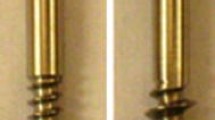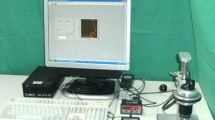Abstract
The pull-out strengths of cortical screws inserted into soft, unpolymerised Refobacin Palacos bone cement (procedure S) and into hardened polymerised cement into which a hole had been drilled and tapped (procedure P) were compared. Cortical screws 58 mm in length, outer diameter 4.5 mm and inner diameter 2.95 mm were used. Screws were inserted into cement cylinders at 5 mm incremental depths between 10 and 30 mm. At a screw depth of less than 25 mm, the screws pulled out, and at a depth of greater than 25 mm, the screws broke in both procedures. There was no statistically significant difference in pull-out strength leading to burst or break between the two procedures for screws inserted to comparable depths, but there was a statistically significant difference regarding the screwing depth regardless of the procedure of screw insertion chosen. The average material stability (σ) of the cortical screws used was calculated to be 1191 N/mm2, and the elasticity limit was 5137 N. This study demonstrated that the material stability and not the depth of screw insertion was the limiting parameter in screw anchorage in bone cement while static testing. To avoid screw breakage due to fatigue during continuous alternate loading, the screws should not be loaded above this value.
Similar content being viewed by others
References
Anderson JT, Erickson JM, Thompson RC, Chao EY (1978) Pathologic femoral shaft fractures comparing fixation techniques using cement. Clin Orthop 131:273–278
Cameron HU, Jacob R, McNab I, Pilliar RM (1975) Use of polymethylmethacrylate to enhance screw fixation in bone. J Bone Joint Surg [Am] 58:655–656
Frandsen PA, Christoffersen H, Madsen T (1984) Holding power of different screws in the femoral head: a study in human cadaver hips. Acta Orthop Scand 55:349–351
Friedl W, Ruf W Mischkowsky T (1986) Die Doppelplattenverbundosteosynthese bei subtrochantären pathologischen Frakturen. Chirurg 57:713–718
Habermann ET, Sachs R, Stern RE, Hirsh DM, Anderson WJ (1982) The pathology and treatment of metastatic diseases of the femur. Clin Orthop 169:70–82
Holz U (1985) Verbundosteosynthese bei Spontanfrakturen am Femur. Akt Traumatol 15:100–103
Iversen BF, Sturup J, Lyndrup P, Jensen NC, Therkilden MH (1988) Screw fixation in the femoral head: Auszug tests in cadavers. Acta Orthop Scand 59:655–657
Kleeman BC, Takeuchi T, Gerhart TN, Hayes WC (1992) Holding power and reinforcement of cancellous screws in human bone. Clin Orthop 284:260–266
Koryanyi E, Bowman CE, Knecht CD, Janssen M (1970) Holding power of orthopedic screws in bone. Clin Orthop 72:283–285
Leggon RE, Lindsey RW, Panjabi MM (1988) Strength reduction and the effects of treatment of long bones with diaphyseal defects involving 50% of the cortex. J Orthop Res 6:540–546
Lintner P, Burri C, Claes L, Plank E, Ruter A (1978) Stabilitatsverhalten und Implantatbeanspruchung von Platten- und Verbundosteosynthesen des Femurschaftes. Akt Traumatol 8:435–440
Motzkin NE, Chao EYS, An K-N, Wikenheiser MA, Lewallen DG (1994) Pull-out strength of screws from polymethylmethacrylate cement. J Bone Joint Surg [Br] 76:320–323
Oest O (1970) Verbundosteosynthesen in mechanischer und funktioneller Sicht. In: Proceedings of the Fifty-Seventh Annual Meeting of the German Society of Orthopaedics and Traumatology, Munich, Germany, pp 367–373
Scheuba G (1966) Die Osteosynthese mit dem Kunstharz Palacos. Chirurg 37:506–508
Scheuermann H, Ege W (1987) Aufbau und Zusammensetzung handelsüblicher Knochenzemente In: Willert HG, Buchhorn G (eds) Knochenzement. Akt Probl Chir Orthop 31:17–20
Sim FH, Daugherty TW, Ivins JC (1974) The use of methylmethacrylate in fixation of pathological fractures. J Bone Joint Surg [Am] 56:40–48
Soshi S, Shiba R, Kondo H, Murota K (1991) An experimental study on transpedicular screw fixation in relation to osteoporosis of the lumbar spine. Spine 16:1335–1341
Strube HD, Ritter G (1985) Die Verbundosteosynthese. Unfallchirurg 88:53–62
Szyszkowitz R (1972) Pathologische distale Femurfraktur. Akt Traumatol 2:91–96
Wittenberg RH, Lee KS, Shea M, White A, Hayes WC (1993) Effect of screw diameter, insertion technique, and bone cement augmentation of pedicular screw fixation strength. Clin Orthop 296:278–287
Author information
Authors and Affiliations
Rights and permissions
About this article
Cite this article
Heller, K.D., Zilkens, K.W., Hammer, J. et al. Does the anchorage form and depth influence the pull-out strength of screws from bone cement?. Arch Orthop Trauma Surg 116, 88–91 (1997). https://doi.org/10.1007/BF00434108
Received:
Issue Date:
DOI: https://doi.org/10.1007/BF00434108




